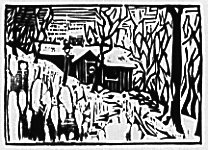
In the next few weeks, there will be an exhibit of Harlan Hubbard's art in the Gallery of the Lynn Center for Fine Arts. That exhibit concludes May 11 with several Alumni Day special events celebrating the lives of Harlan and Anna Hubbard and their influence on generations of Hanover students. But who were the Hubbards and what was that influence?
Harlan was born close to his beloved Ohio River in 1900. During his 88 years, he became perhaps the greatest artist of that river world. In woodblock prints, water colors and paintings, he presented his singular vision of riverboats, rivertowns, and farms.

His art began in adolescence and continued with stubborn persistence until his passing. It was grounded in a rich knowledge of the art world, but stayed true to his own slant. Always, it reflected the innumerable moods of the river and its environs.
His work is still not fully documented, but yielded more than 700 paintings, 1,200 watercolor drawings and countless other pieces. While some of these are on permanent display at the College, many others have been collected and displayed by area museums and private individuals. Some of these are included in the current special exhibit.
But Harlan's strongest appeal came from the exceptional life he shared with his wife, Anna, through 45 years. A hidden life, lived "on the fringes of society," it was nonetheless a wonderfully public life, made available through Harlan's writing.

"Shantyboat," which Harlan wrote in 1953, takes us along on the couple's homemade drift boat as they travel from rural Kentucky to New Orleans via the Ohio and Mississippi rivers. The trip took several years, its pace varying with the river's seasons. There, the Hubbards learned many of the arts of self-sufficiency and simplicity, and the joys of living immersed in nature, which sustained the rest of their life.
"Payne Hollow," written 20 years later, invites us into the circle of a year in their life as homesteaders in the remote valley in Trimble County, Ky. The property is located right on the Ohio, just a few miles downstream from the College.
Many marveled at the Hubbards' self-reliance, but to them, it was the only way to live. Harlan once wrote, "Sweet water to drink, pure air to breathe, naturally grown food and such delights to the soul as space, quiet, solitude and dark nights—these rewards outweigh by far the time and energy required to achieve them."
It was this life into which generations of Hanover students were welcomed as guests and as friends. The Hubbards were gracious hosts, even if visitors interrupted a scheduled activity. "With a little encouragement, nearly everyone has something to say that is worth listening to," Harlan once said.
Often, visits with the Hubbards gave the students great insights. How many of them left with the dream of building their own rustic home and furnishing it simply? Of finding delight and meaning in raising and gathering their own food? Of living in an unspoiled setting?
Many found it difficult to leave Payne Hollow at the end of their visits. Even today, after both Anna and Harlan have passed away, images of the Hubbards are etched indelibly in the mind—Anna reading aloud while Harlan washed dishes or fixed a lantern; Anna beginning a Mozart piece at the piano as Harlan tuned his violin.
In 1985, Harlan donated a diverse collection of his art to Hanover College. Several pieces hang in the J. Graham Brown Campus Center. His donation was a gesture of friendship to an institution that had provided books, concerts and a community of friends.
In that spirit, the Friends of the Hubbards is an informal group, based at the College. Members cherish the Hubbard legacy and work to extend it through events like the exhibit this spring. The Friends of the Hubbards also produce an occasional newsletter. Those wishing to be added to the mailing list should contact Hanover's Office of Development by mail (P.O. Box 108, Hanover, IN 47243-0108), phone (812-866-7011), or email (kindlspr@hanover.edu).
Harlan Hubbard, Payne Hollow: Life on the Fringe of Society,
Gnomon Press, Box 475, Frankfort, KY, 40602-0476, 1953.
Harlan Hubbard, Shantyboat: A River Way of Life,
University Press of Kentucky, 1974.
Wendell Berry, Harlan Hubbard: Life and Work,
University Press of Kentucky, 1990.
Don Wallis, Harlan Hubbard and the River: A Visionary Life,
OYO Press, Box 476, Yellow Springs, OH 45387, 1989.
Robert J. Rosenthal is a professor of philosophy at Hanover College, where he has worked since 1967. He earned his bachelor's degree at St. Olaf College (Minn.) and his doctorate at the University of Maryland. Rosenthal is a member of the Friends of the Hubbards, and has led generations of Hanover students into field study of "the simple life" through the Spring Term course, "Utopias and Intentional Communities," which examines monasteries, communes and Amish societies.
|back||current issue||publications||homepage|